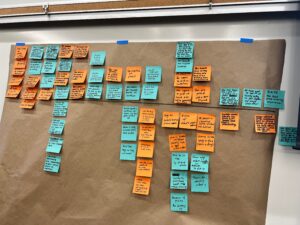May is a college senior in the midst of midterms, all while juggling her law school essay applications. She is not craving the routine dining hall food and she feels that she has been spending too much time alone in her room studying and writing her application essays. In hopes to order her favorite Indian food and meet a new friend, May reaches for her phone and clicks on “Plates”.
Plates is where affordable and convenient food delivery meets social networking. Our customer segment is college undergraduate and graduate students in the United States who don’t cook, don’t have ample time to get food while on campus, or are seeking new relationships over a shared meal. By connecting people through affordable, convenient, and enjoyable meals, we hope to be a user’s bridge between a good meal and good company.
For our Minimum Viable Product (MVP), we are creating the first iteration of our mobile app that will have a page where users can view the restaurants of the day and then proceed to select an order pickup time, order pickup hub, and then enter their payment information. The detail of the process is as the following image. The general features in this phase will be fairly simple as we want the user’s on-boarding experience to be as time-efficient as possible. Regarding the plates matching process, we are prototyping the functionality where a user places their order and receives an in-app notification with information regarding the first name, last initial, and a short biography of their match.

Our hypothesis statements revolve around three core ideas: 1) We believe people like Stanford students have a desire to meet people over a shared meal. We will know we have validated this when 100 people create their profiles on our application. 2) We believe people like Stanford students will not have to worry about getting their meals timely by ordering convenient, affordable, and enjoyable meals through Plates. We will know we have validated this when we see 100, successful, plates matches. 3) We believe our application can provide a new medium of social connection by creating a group, food-order platform. We will know we have validated this when we see that 80% are satisfied and will refer a friend.
During week 4 and week 5, we developed several key assumptions based on our user interviews and market research. Some of our core assumptions included: 1) People want to pay a cheaper fee than what UberEats/DoorDash provides 2) People are willing to travel to the pickup location at a specific time window given the food is cheaper and better 3) People plan their dinners around 1.5-2 hours ahead of time 4) Users are comfortable being paired and sharing a meal with a stranger. 5) Restaurants making all food in the group order would finish on time. We decided to test the third assumption by asking 10 people what their dinner plans are for the night. We asked if they had made these plans at least 90 minutes to two hours in advance of the actual meal and discovered that 1 person originally had plans but the other individual canceled, 1 person had plans but was delayed, 2 people didn’t have plans, and 6 of the 10 people had plans that they carried out successfully.
Regarding advice that we’re interested in seeking from our reviewers, we would like to receive feedback on the following questions:
- Regarding the matching process, a concern we have is how much information a Plates user should get about their match; should we make the match completely anonymous, or should each of the two users get some information about each other, such as their first name and a short biography?
- To what extent should we be concerned about users canceling on their matches–should there be a mechanism (i.e. cancellation fee) in place to decrease the likelihood of canceling or flaking?
- Assuming that the matched users find each other successfully, to what extent should we be involved to help facilitate a comfortable or meaningful interaction during their meeting?
- Should the MVP allow for orders to be placed further out in advance (e.g. a week in advance)?
Regarding next steps, we are looking towards developing our prototype and meeting to discuss the look and feel of the app. Moreover, we are continuing to get feedback from prospective users, with an emphasis on making sure that the features we are including our MVP are features that our interviewees would be interested in, such as being able to order a week in advance versus the day of the order.
Value Proposition Statement
Our food group-order and plate-matching platform helps college students in the US who don’t cook or are, who want to meet new people during meal time and to get good food on campus by reducing the time to get good, cheap, and diverse food off campus and enabling them to meet new friends during lunch time, unlike Doordash, which is not only expensive and doesn’t have community aspect.
Value Proposition Canvas
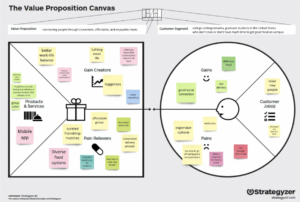
Comparative Research

Business Model Canvas

Experience Prototype
Core Assumptions:
- People want to pay a cheaper fee than what UberEats/DoorDash provides (Solmih)
- Interview 10+ people on how much they currently pay for the food delivering platforms
- Ask how much they would ideally want to pay
- People are willing to travel to the pickup location at a specific time window given the food is cheaper and better (Chih-Ling)
- Test on 10 people and ask them what would they choose among their lunch options (doorDash, dining hall, plates) by actually having food (e.g. Zareen’s) cheaper, we pick up the group order from Zareen’s and letting the users pickup at Tressider at 12:30-13:30
- People plan their dinners around 1.5-2 hours ahead (Emmy)
- Ask 10 people what their dinner plans are tonight (1.5 – 2 hours before)
- If they have plans, go into specifics (location, time, people they are eating with etc)
- Results (1.5-2 hours – everyone who we interviewed ate at around 5.30-7):
- 1 person: originally had plans, but other person canceled
- 1 person: had plans, but delayed from original time
- 2 people no plans for dinner
- 6 people plans: El Dia de los Muertos dinner at dining hall x 2, off-campus x 2, skipping dinner 1, eating with friend at dining hall x 1
- Results (1.5-2 hours – everyone who we interviewed ate at around 5.30-7):
- Users want to be paired with a stranger and feel comfortable sharing a meal with them. (Vivian)
- Interview 10 people and ask them if they are comfortable eating with other people.
- Restaurants making all food in the group order and finishing on time (Michelle)
- Call restaurant manager (T4, Yayoi, Sushirito, Onigilly, and Crepevine) and ask how long it takes to process takeout order
- How long does it take from when user order food to when food arrives
Hypotheses
- We believe people like Stanford students have a desire to meet people over a shared meal. We will know we have validated this when 100 people create their profiles on our application.
- We believe people like Stanford students will not have to worry about their meals by ordering convenient, affordable, and enjoyable meals through Plates. We will know we have validated this when we see 100, successful, plates matches.
- We believe our application can provide a new medium of social connection by creating a group, food-order platform. We will know we have validated this when we see that 80% are satisfied and will refer a friend.
Participatory Roadmap
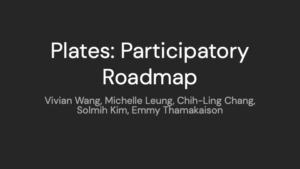
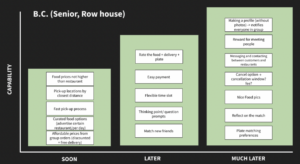

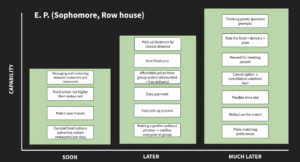

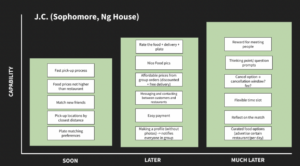
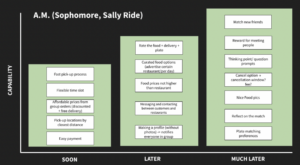


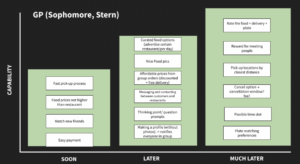

Assumptions Map

User Story Roadmap
